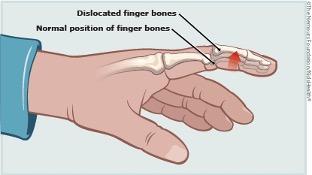Topics
Dislocated Finger: How to Care for Your Child

With proper treatment, most kids who dislocate a finger can gradually return to their normal activities. The finger may feel sore or stiff for a while.
Your Child's Diagnosis
A dislocation is when the bones in a joint slip out of their normal position. A finger dislocation may happen from a fall, blow, or sports injury, especially if the finger is bent back or jammed.
Your child had X-rays to diagnose the dislocated finger. The bones may have moved back into place on their own or the health care provider may have gently put the joint back with a quick maneuver called a reduction. In some cases, surgery is needed to repair the joint.
To keep the joint from dislocating again, the health care provider put a splint on the injured finger or taped it to the neighboring finger ("buddy taping"). Depending on the injury, your child will have a splint or taped fingers for a few days to a few weeks. The health care provider may also recommend gentle hand exercises to help strengthen the finger and reduce joint stiffness.
Home Care Instructions
- For the next few days:
- Put a cold pack or plastic bag of ice wrapped in a towel on the finger for 15–20 minutes three or four times a day. Do not place ice directly on the skin.
- To keep swelling down, your child should keep the hand raised above the heart as much as possible. Try propping it up with pillows.
- If your child is uncomfortable, a medication may help:
- For children under 6 months, you may give acetaminophen.
- For children over 6 months, you may give acetaminophen OR ibuprofen, if recommended by your health care provider.
- If your health care provider recommended hand or finger exercises, your child should do them as instructed.
- If your child has a splint, follow your health care provider's instructions for taking care of it. Do not try to remove or adjust it unless instructed by your health care provider to do so.
- If your child has buddy tape, remove the tape and replace it as you were shown each day or anytime it becomes wet or soiled. Have your child use a hand sanitizer to clean hands except for when visibly dirty and washing is needed.
Special Instructions
- Schedule a follow-up appointment with the orthopedic doctor (bone specialist) as directed.
- Ask your health care provider when it's OK for your child to return to sports. The health care provider may recommend protective hand gear or taping for sports play.
Call Your Healthcare Provider if...
- The finger dislocates again.
- Pain doesn't improve with medication.
- Swelling doesn't improve with propping the hand up.
Go to the ER if...
- The finger is blue, pale, cold, or numb.